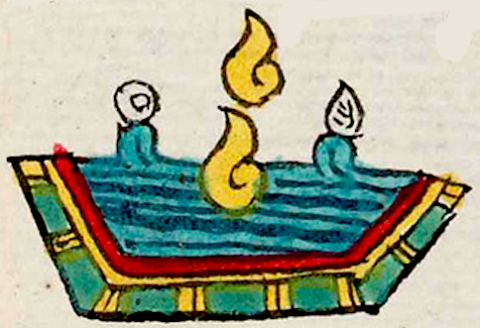Acuitlapan (Mdz39r)
This compound glyph for the place name Acuitlapan (perhaps, "In the Algae") includes two pieces of curling yellow excrement (perhaps gold teocuitlatl) in Nahuatl, dropping into a cross-section of a structured canal (apantli) with blue-green or turquoise water (atl), with the typical wavy lines of current of varying thicknesses and a turbinate shell and a drop of water (or a chalchihuitl) splashing off the top of the water. The water channel has some thicker black lines and an especially elaborate containment on the bottom and the sides, with carefully constructed details and selected colors. The outer-most layer of the containment is green with perpendicular yellow hash marks. Inside that is a yellow liner, and inside that is a red liner. Together, the excrement and water create a fully phonetic compound hieroglyph.
Stephanie Wood
There was an Acuitlapan in what is now the state of Guerrero. It is now called Taxco de Alarcón. The presence of gold and silver mines in this region may be significant. Gold was teocuitlatl (divine excrement), and this excrement is colored yellow, like gold, rather than brown. The "apan" from apantli is broken into two parts, with the "cuitla" in the middle. Another possibility, however is simply atl (water) plus cuitlapan, which can mean two different things, "behind" or "dung heap." The result, therefore, might be "Behind the Water" or "On the Water Dung Heap." The latter is what Berdan and Anawalt favored in their publication of The Codex Mendoza. Frances Karttunen suggests "Watery Excrement Place."
Bodily and deity excretions probably did not convey the same repulsion as experienced by modern audiences. Besides teocuitlatl (divine excrement) there was cuitlatexotli (excrement blue). (See Allison Caplan, 2020, 391.) The latter was not as prized as the blue of the lovely cotinga feathers, but probably not repulsive to Nahuas. The poisonous excretion of toads also had a positive side, as it was used in rituals as a hallucinogenic.
Stephanie Wood
acuitlapā. puo
Acuitlapan, pueblo (Taxco de Alarcón, Guerrero, today)
Stephanie Wood
c. 1541, or by 1553 at the latest
Stephanie Wood
The cuitla(tl) drops into the apan(tli), but the a- at the beginning of the place name, which is a[tl] (water), could also be derived from the presence of the water in apantli. Thus, we would have bottom-to-top and then a top-to-bottom reading order, or up then down. If the excrement is seen as in front of the apantli, then the reading is also front to back.
water canals, water channels, excrement, excresence, gold, water, shells, nombres de lugares

acuitla(tl), blue-green algae, a food source, https://nahuatl.wired-humanities.org/content/acuitlatl
a(tl), water, https://nahuatl.wired-humanities.org/content/atl
apan(tli), water channel/canal, https://nahuatl.wired-humanities.org/content/apantli
-apan (locative suffix), on or at the waters of, https://nahuatl.wired-humanities.org/content/apan-0
cuitla(tl), excrement or excretion, https://nahuatl.wired-humanities.org/content/cuitlatl
cuitlapan, dung heap, or behind, https://nahuatl.wired-humanities.org/content/cuitlapan
-pan (locative suffix), https://nahuatl.wired-humanities.org/content/pan
"Watery Excrement Place." She also adds: since precious metals are called teo:cuitla- 'divine
excrement' and obsidian ci:tlalcuitla- 'star excrement', it seems possible to me that ācuitla- 'water excrement' might be some useful substance like fly larvae or green algae (both foodstuffs). If so, the place name would reflect that change in meaning. [Frances Karttunen, unpublished manuscript, used here with her permission.]
"Behind the Water" (Stephanie Wood); "On the Water Dung Heap" (Berdan and Anawalt, vol. 1, p. 169)
Codex Mendoza folio 39 recto, https://digital.bodleian.ox.ac.uk/objects/2fea788e-2aa2-4f08-b6d9-648c00..., image 88 of 188.
The Bodleian Libraries, University of Oxford, hold the original manuscript, the MS. Arch. Selden. A. 1. This image is published here under the UK Creative Commons, “Attribution-NonCommercial-ShareAlike 3.0 License” (CC-BY-NC-SA 3.0).




